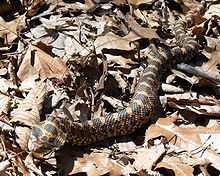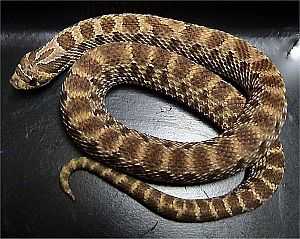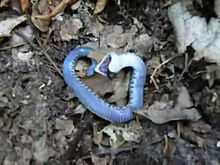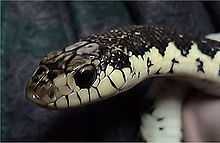Hognose
| Hognose Snake | |
|---|---|
 | |
| Eastern Hognose Snake, Heterodon platirhinos | |
| Scientific classification | |
| Kingdom: | Animalia |
| Phylum: | Chordata |
| Class: | Reptilia |
| Order: | Squamata |
| Suborder: | Serpentes |
| Family: | Colubridae |
| Subfamily: | Xenodontinae |
| Genera | |
The term hognose snake is used to describe several snakes characterized by an upturned snout. The North American species (genus Heterodon) are notorious for playing dead when threatened. The hognose snakes consist of three distantly related genera that are artificially grouped together by the "hognose" common name: Heterodon, which are predominantly found in United States and northern Mexico, Leioheterodon, the hognose snakes native to the Madagascar, and Lystrophis, the South American hognose snakes.
Species
Genus Heterodon:
- Mexican hognose snake, Heterodon kennerlyi (Kennicott, 1860)
- Heterodon nasicus
- Eastern hognose snake, Heterodon platirhinos (Latreille, 1801)
- Southern hognose snake, Heterodon simus (Linnaeus, 1766)

Genus Leioheterodon:
- Speckled hognose snake, Leioheterodon geayi (Mocquard, 1905)
- Malagasy giant hognose snake, Leioheterodon madagascariensis (Duméril & Bibron, 1854)
- Blonde hognose snake, Leioheterodon modestus (Günther, 1863)
Genus Lystrophis:
- South American hognose snake, Lystrophis dorbignyi (Duméril, Bibron & Duméril, 1854)
- Jan's hognose snake, Lystrophis histricus (Jan, 1863)
- Lystrophis matogrossensis (Scrocchi & Cruz, 1993)
- Tri-color hognose snake, Lystrophis pulcher (Jan, 1863)
- Ringed hognose snake, Lystrophis semicinctus (Duméril, Bibron & Duméril, 1854)
Description
Hognose snakes' most distinguishing characteristic is their upturned snout, which aids in digging in sandy soils by using a sweeping, side to side motion. They also like to burrow in masses of humus. Lieoheterodon species are known to dig up the eggs of lizards.[1]
Hognose snakes are extremely variable in color and pattern. Heterodon nasicus and H. kennerlyi tend to be sandy colored with black and white markings, while H. platirhinos varies from reds, greens, oranges, browns, to melanistic (i.e. black) depending on locality. They are sometimes blotched and sometimes solid-colored. Leiohetereodon geayi is a brown or tan colored snake with dark speckling on it. Leioheterodon madagascariensis is typically green and yellow with a black checkerboard pattern along its back. Leioheterodon modestus is normally a gold-brown color. Some species in the genus Lystrophis are referred to as tri-color hognose snakes and sometimes as false coral snakes because they display alternating bands of red, white, and black.
Leioheterodon are the largest of the hognose snakes, capable of reaching lengths of 1.8 m. Heterodon platirhynos gets slightly larger than other species of the genus, reaching lengths of 80 cm, where other species in the genus as well as Lystrophis species usually average around 65 cm at adult size.
Hognose snakes (Heterodon) are rear-fanged. The fangs have been referred to as just "enlarged teeth", but they are genuine fangs that are used for prey restraint. Despite the common belief, there is no evidence to support the fangs being used for "toad popping". Under this belief, the toads inflate their lungs to make swallowing difficult, but the fangs would penetrate the lungs and deflate them. However, whole toads with intact lungs are commonly regurgitated by recently captured hognoses.
Behavior

When threatened, hognose snakes will flatten their necks and raise their heads off the ground, like a cobra, and hiss. They may sometimes feign strikes, but Heterodon bites are extremely rare. This behaviour has earned them several nicknames, such as "puff adder", "blowing adder", "flathead", "spreadhead", "spreading adder" or "hissing adder". Note: the nickname "puff adder" is only a nickname, and is not scientifically correct. There is a highly venomous viper from Africa called the puff adder, Bitis arietans.
If this threat display does not work to deter a would-be predator, Heterodon species will often roll onto their back and play dead, going so far as to emit a foul musk and fecal matter from their cloaca and let their tongue hang out of their mouth, sometimes accompanied by small droplets of blood. If they are rolled upright while in this state, they will often roll back as if insisting they really are dead. It has been observed that the snake, while appearing to be dead, will still watch the threat that caused the death pose. The snake will 'resurrect' sooner if the threat is looking away from it than if the threat is looking at the snake.[2]
They are rather timid snakes and will often hide from predators by burrowing down into leaves, sand etc.

Diet
Heterodon are diurnal active foragers that typically consume their prey live without any constriction or body pinning, primarily relying on only their jaws to subdue their prey.
For most hognose snakes the bulk of the diet is made up by rodents, and lizards. Heterodon platirhinos is an exception, and specializes in feeding on toads although other food items such as eggs, insects and mice can make up as much as 50% of their diet.
In captivity
Hognose snakes are frequently found in herpetoculture. Heterodon nasicus are often considered to be the easiest to care for, and captive bred stock is easily found. Heterodon platirhinos is also commonly found, but their dietary requirements can be a challenge for some keepers, and there is anecdotal evidence to suggest that feeding them a diet of exclusively rodents contributes to liver problems and a shortened life span.[3] Leioheterodon species are imported regularly from Madagascar, and are not often bred in captivity and get much larger, so can pose a set of different challenges for care. Lystrophis species are fairly new to the commercial reptile trade, and are now commonly bred in captivity, but can be some of the more expensive hognose snakes available.
Toxicity
There has been some debate over whether hognoses are venomous. Their saliva is toxic to small prey such as frogs and toads, and thus meets the definition of venom. However, it is not likely to cause serious injury to humans, particularly as hognoses are rear-fanged[4] and do not bite in defense (i.e., the only way to get bitten by a hognose snake is to smell like their prey). In rare cases, humans may experience local swelling and blistering as a result of a bite.
Popular culture
- The song "Copperline" by James Taylor contains the lyrics:
- "Half a mile down to Morgan Creek, leaning heavy on the end of the week.
- Hercules and a hognosed snake, down on Copperline, we were down on Copperline."[5]
References
- ↑ Glaw, Frank; Vences, Miguel (2007). A Field Guide to Amphibians and Reptiles of Madagascar 3rd edition. Köln: M. Vences & F. Glaw Verlags GbR. ISBN 978-3-929449-03-7.
- ↑ Burghardt, G.M.; Greene, H.W. (1988). "Predator simulation and duration of death feigning in neonate hognose snakes". Animal Behaviour 36 (November–December): 842–44. doi:10.1016/S0003-3472(88)80127-1.
- ↑ Hognose.com: Eastern Hognose Species Description
- ↑ Hognose Snake Care Sheet
- ↑ "Carolina on my mind: The James Taylor story," exhibit at the Chapel Hill Museum, Chapel Hill, North Carolina. Information retrieved 2007-12-24.
External links
- thehognosesnake.co.uk Hognose snakes are really important.
- Hognose.com
- Dutch Breeder of colour mutations of hognose, many pictures
- The European Molecular Biology Laboratory Reptile Database
- *Western hognose snake Species account from the Iowa Reptile and Amphibian Field Guide
- *Eastern hognose snake Species account from the Iowa Reptile and Amphibian Field Guide
- World of Hognose Website for color mutations with pictures, breeders, and advice for the care of hognoses